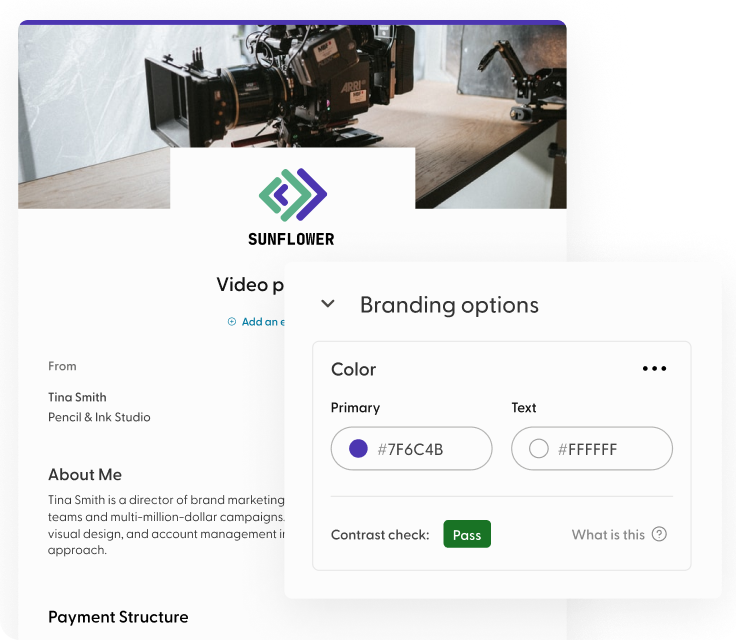After you send a proposal, it's challenging to wait to hear whether or not you've landed the gig. That's why a proposal follow-up email can be just the ticket you need to book your next client. So, if you're wondering when you can follow up with your potential client or what to say, you're in the right place!
In this article, we'll cover the cadence of when you should send proposal follow-up emails and some copy and paste templates to adapt to your own needs.
Why send a follow-up email?
Follow-up emails can cut through the noise of a recipient's clogged-up inbox. Not only does it serve as a reminder to the recipient that you're interested in working with them, but sending another email can be extremely helpful in leaving a strong impression.
Many freelancers don't send a second email, so doing so automatically makes you stand out in their inbox as someone who really wants to work with them. An email sequence also gives you a chance to refine your messaging and hone in on their current needs.
How many times have you ignored an unknown email or phone call?
Chances are pretty high that when you don't recognize a phone number, you ignore the call to see if they leave a voicemail. But if that same number calls you multiple times, you're suddenly more curious about who they are and what they need from you.
This is a process of warming up a cold email so that clients take more interest in working with you. A strong follow-up can:
- Add value with each interaction
- Build credibility
- Encourage the client to follow up on your call to action
- Show you're interested and reliable
- Sets you apart from the competition
Tips for brilliant follow-up emails
You want to strike the perfect balance in your follow-up email between reminding, connecting, and nagging. There's a fine line between getting their attention and pushing them away! We've got you covered with a few simple tips.

Write a cheerful and useful email subject line
A killer subject line is important for your message to get read, so your follow-up email should start with a nice subject line. Follow-ups should start with a subject line that gets attention in the client's inbox, which can be accomplished in a variety of tones.
Your subject lines can be intriguing, urgent, cutesy, funny, or informative. After you take some time to learn about the client you're pitching, you can decide which tone would be most effective for them. You can always try mixing up your tactics if one isn't working for you.
If possible, reference the previous email, use the name of your prospective clients, and add more details to get their attention.
Build a follow-up sequence
Don't cover the entire sales process in a single follow-up as too much information can overwhelm the recipient. Instead, plan for multiple messages.
Studies show that shorter emails typically get a higher response rate than longer emails, so remember to keep your emails short and to the point.
Build your messaging and urgency throughout the follow-up email sequence. Hold off on more in-depth conversation for when you can meet the client in person or on the phone. The key is to provide them with enough information for them to understand exactly what you're proposing, and let them know that you'd be happy to give them the rest of the details on a phone call.
Send your follow-up email to the appropriate person
Many times an email goes unanswered because your pitch was sent to the wrong person, so make sure you have the right details for your contact. Try to work out where they fit in the prospect's company, such as their job function, whether they can move the deal forward, and who their boss might be.
You can typically find this information on their website by looking through their team members. Send the follow-up email to them, but keep the sales process in mind because you might be writing to more than one person.
Although many companies don't publicly display employee emails, so you may need to use a third-party website that can provide this information to you. Or, you can always try to guess their email based on the company emails that they do make public. The worst that happens is that an email will bounce back if you guess incorrectly, so it doesn't hurt to try to guess!
Write a clear call to action
Having a strong call to action is one of the most crucial elements to your pitch being a home run with a client. Your follow-up email should have a call to action that references the sales proposal and helps prospective clients take the next step in the sales cycle.
A call to action should clearly state what you want your client to do next, such as replying to your email with a couple of times that would work best for them to jump on a quick call with you.
Make this happen by sitting down for fifteen or twenty minutes. Write a call to action and then create a few variations to use for potential clients.
By the way, you can do the same thing with subject lines. Feel free to create 5-10 subject lines to use for your follow-up email templates.
Don't be "salesy"
It may go against the term "sales pitch," but your sales pitches shouldn't sound salesy. Years of marketing have caused people to pick up on when they are being sold to. So whenever we hear salesman lingo, we immediately tune out the rest of the pitch.
The important thing to remember is, people don't mind being sold to as long as there is enough value being provided. So, as you craft your emails, try to limit any elements that sound like a traditional sales proposal.
Instead, try to focus on their business needs and how you can help them achieve their goals. You want to position yourself as the solution to their problems. By doing so, you're no longer acting as a salesman, but as a real partner to their business.
If you find that a lot of your pitches go unanswered, or even unread, reexamine your emails to make sure they don't sound like a sales pitch. The same goes for your email subject line. Every part of your email should be providing value that the recipient can't wait to read.
And better yet, an email they can't wait to respond to!
Avoid the email blast
It can be tempting to send one email template to every client, but there are a couple of things you should consider before doing that. When you send one email to hundreds of businesses, you need to be careful that the email doesn't sound too generic.
The trick to a great template is that you build your personality on top of the template. Take some time to research your prospective clients to show that you care about their specific needs. Let the businesses know a little about you and how you can help their goals.
The more the template feels like it's speaking directly to them, and not a hundred other businesses, the more they'll want to respond to you. Your emails are the first steps to building a relationship with a client, so think of your emails as a conversation and not just a chance to ask for a gig.
The more you view an email follow-up as the further development of a conversation, the more you'll increase your chances of sparking a phone call and, ultimately, a long-term client.
Indy makes this process simple with automated email follow-ups. It can take a chunk out of your day when you have to remember to write back to clients. But with Indy, you can set up automated workflows to send follow-up messages to clients at just the right moment. Set the automation up once, and you won't have to think about it again!
When to send a proposal follow-up email
There are two different methods that you can pitch a client - in person and via email. The method you present a proposal all depends on the situation and the type of information that's needed. More elaborate pitches may need a more formal proposal, whereas other times an email or word document will suffice.
In-person proposals
After the presentation is when you're able to follow up with your client for the first time. In this email, you can thank them for their time, send along the presentation or documents you went over during the meeting, and ask them what the best next steps are. Below you'll find an initial template for this first follow-up email.
Email #1: Follow-up email template to use after an in-person meeting
Subject
Thank you for taking the time to meet with me today.
Message
Dear Prospective Client,
Thank you for taking the time to meet with me today. I'm really excited about the opportunity to help you grow your business and collaborate to meet [client's company] goals. As promised, I have attached the presentation I gave earlier today and supporting data. If any questions arise while reviewing the data, don't hesitate to reach out. In the meantime, I'll plan on circling back next week to follow up if I don't hear anything.
All the best,
[your name]
Email proposals
If you're sending a proposal via email, your follow-up strategy will differ. Instead of sending an email immediately after you send your proposal, waiting 3-5 business days before you follow up is common.
While it's definitely possible for clients to respond after only one email, more often than not, a follow-up on an email cold pitch is crucial to you landing the gig. That's because, just like in marketing, customers (or clients) often need to be sold to more than once to feel comfortable working with you. That's why companies send email sequences out to customers.
The more you hear from a company, the more you'll be interested in their products. In this way, cold pitching a client is a lot like marketing. This gives your client ample time to review the sales proposal without forgetting who you are.
However, follow-up messages that are sent too soon will push prospective clients away.
Below you'll find some post-proposal follow-up templates you can use for each circumstance.
Email #2: Follow-up email template to use after the initial cold email
Subject
I'm excited about the idea of working together.
Message
Dear [client's name],
I hope you're doing well. I wanted to follow up to ensure you received my email and see if you had any initial questions. I'm happy to discuss this with you further if it would be helpful.
Thank you again for this opportunity, I'm excited about the idea of working together.
All the best,
[your name]
Follow-up email after sending proposal templates
Regardless of whether you've pitched in person or via email, here are a few other follow up email templates you can use after pitching a business proposal.

Email #3: Follow-up email template to offer additional support and answer remaining questions
This is the most common follow-up email and it offers additional support to answer questions. The value of this follow-up email is that it shows your possible client that you're prepared to support them.
Subject
Do you have any additional questions?
Message
Dear [Client's name],
I hope you're doing well. I wanted to follow up on my proposal last week. I'm really excited about the opportunity to work together and wanted to see if you had any additional questions or concerns that I can address.
Please let me know if there's any way I can support you during this time.
All the best,
Consultant
Email #4: Follow-up email template to use when you haven't heard back after the date your client said they'd inform you
If your client hasn't gotten back to you by the time they said they would, here's a good follow-up email that connects with them and asks for an updated timeline. With all follow-up emails, ensure that you are offering value to them and thinking of their possible needs.
Subject
I wanted to follow up with you regarding the pitch I sent last week.
Message
Hi [Client's Name],
I hope your week has been going well. I wanted to follow up with you regarding the pitch I sent last week. I know you were hoping to respond by X date and it there seems to be a short delay.
If possible, would you be able to provide an updated idea of when I might hear back for planning purposes?
In the meantime, I'm here to answer any additional questions you might have.
Thanks,
Consultant
Email #5: Follow-up email template to use if you haven't heard anything after several weeks
If several weeks have gone by and you still have heard nothing, sending a final follow-up email is okay. With all communications, be mindful of your prospective client's needs and communicate with respect.
Even if you feel like you're being ghosted, communicating kindly is important in maintaining relationships and leaving doors open. Remember, you can always pitch them again a few months down the road. But for now, it's best to let this be your last point of contact. Here's a sample follow-up email when you haven't heard back in weeks.
Subject
I wanted to send one last follow-up for the time being.
Message
Hi [prospective client],
I wanted to send one last follow-up for the time being. I know this year has been a bit crazy, so understand if business needs have changed. If you're still interested in working together, I'd love to discuss in more detail.
Alternatively, please let me know if support in the future may be needed. Wishing you and your business all the best.
Sincerely,
Consultant
Bonus: Follow-up email template for reconnecting months later
Here's a bonus proposal follow-up email you can use months later (four or more months down the road). Just because a client didn't respond back to your first follow-up email sequence doesn't mean they won't respond back now. You might have just caught them at a busy time, whereas now they may be more open to working with you. Here's how you can touch base again.
Subject
How are things going?
Message
Hi [prospective client],
I was thinking about you today and wanted to ask how things are going?
I've been working on some exciting projects with several current clients and we're getting great results. I'd love to share some ideas with you.
Do you have a few minutes to chat over the phone this week? I have [these days] and [these times] available.
Looking forward to hearing from you.
Sincerely,
Consultant
As with any template, follow-up email templates work best if you take the examples we've provided and mold them so they feel more personalized to you.
And just like these email templates, Indy's Proposals tool takes the guesswork out of creating a winning proposal. Just choose the template that matches your industry, fill in the details, and it's ready to send. You can monitor the status of each proposal, and even automate your follow-up messages so that your business runs around the clock (even when you're resting).
The art of a great subject line
An email subject line is one of the most important parts of sending a great proposal follow-up email. If you don't entice them enough to open the email, they won't click to read what's inside. Here are some tips to write killer subject lines:
- Be personal: You can personalize an email by adding the recipient's name in the subject line. This helps grab their attention.
- Be conversational: You don't want to sound pushy or salesy in the subject line (or the email). A friendly, relaxed tone sounds much more genuine and increases the chance of it getting opened.
- Be brief: Don't use more than 10 words in your subject line, as any more won't be shown to the recipient. Get to the point quickly.
Subject lines are a key part of the sales proposal process, so write down a few variations until you land on the right one. By keeping them brief and personalized, you'll be able to craft a killer email subject line in no time.
Reasons why a potential client may not respond
Our initial instinct might be to assume that we did something wrong, but that's not always the case. There are many reasons why potential clients might ignore a proposal. Here are some of the biggest reasons:
Clients get busy
This is the biggest reason why you might not hear back. A potential client might have read your previous email but didn't have the time to respond. And after a while, forgot about your email altogether. People get busy with the long list of other tasks they need to get done. This is especially true if you pitched them on services they were interested in, but didn't necessarily need at that moment. In this situation, sending a simple follow-up email can help you set up a time to reconnect with them again later.
Not the right timing
Along with a client being busy, it might just not be the right timing. They don't need your services at the moment, but that doesn't mean they won't need them months later. This is why sending that bonus proposal follow-up email from above can be a crucial step in reigniting contact with a potential client. They'll have had a few additional months to warm up to the idea of working with you and may need your services more than ever.
Emails are going to spam
Do you find that potential clients are ghosting you often? It might be time to consider that your emails could be going to spam. There are plenty of reasons why your follow-up emails could be getting flagged. When emails are flagged, sometimes they get through to the recipient, and other times they don't. You can check to see if your emails are going to spam by using a spam email test.

How many follow-ups should you send?
There's a limit to where your emails will start to do more harm than good. Put yourself in your client's position: you have a packed schedule trying to manage your business and keep your customers happy. Your emails keep piling up as the hours tick by. It can be stressful running a business while staying on top of your emails.
So while it's important to send a reminder of your proposal, it's just as important to not overwhelm the recipient.
Generally, three follow-up emails should be your limit. Any more and you can risk pushing your client away. Keep in mind, just because they don't respond now doesn't mean they won't respond a few months down the road. Your services may just not be needed at the moment, but that won't always be the case. You can always try pitching them again in the future!
Some final tips for crushing your follow-up emails
The art of the perfect pitch can be tough to tackle, so here are a few final ways you can stay on top of your follow-up emails.
Maximize your pitches by creating a "follow-up system"
As you begin pitching businesses, you'll need a system to keep track of who you've pitched and who you still want to pitch. The best way to do this is to create a document that lists out all of the businesses you would like to work with. As you work your way through the checklist, mark which businesses are interested, which are not, and which businesses didn't respond to your emails.
To really stay on top of your pitches, you can mark down the date you send each email. This way, you'll know when you last pitched a business, so you can determine how far down the road you should try pitching them again.
This checklist also comes in handy for keeping track of how many follow-up emails you've sent to a budding client so you won't overpitch them.
Dealing with radio silence
Clients can get extremely busy with their businesses, which is why you'll absolutely want to send some follow-up emails to remind them about your offer. However, if none of your emails get a reply, it's best to move on to other prospecting clients.
There are millions of businesses around the world for you to reach out to, so your time will be better spent contacting the other businesses out there. There are plenty of other clients who need your help and will be thrilled when you reach out to them!
Responding to a client who isn't interested
Sometimes you'll hear back from a client who is kind enough to let you know that they received your message and are not interested in your services. It's nice to know that your emails are getting through, but it's also a disappointing response to receive.
Instead of cutting your losses, this is your chance to further show how much you appreciate them and care about their business goals. You can send them a follow up email thanking them for taking the time to respond to you. Also, let them know again that you'd be happy to reconnect in the future when their schedule opens up.
This kind of response leaves a lasting impression, keeping you at the top of their mind for future work. Again, just because they don't need your services now doesn't mean they never will. And the first chance they do, they'll remember you.
By keeping the interaction light and friendly, they might even recommend you to their friends the next time they hear their colleagues need the services you provide.
Conclusion
Don't give up after you send that first email! Cold pitching a business can take some time as you warm your client up to the idea of working together. A sequence of follow-up emails will increase your chances of landing a client because it gives them a chance to consider your offer and more time to better get to know you.
For more templates and tips on how to engage former clients, check out Indy's article on connecting with clients during COVID-19.
If you want even more templates for your freelance business, check out Indy's Proposals tool. Choose from a variety of templates, customize the content, and get notified as soon as a client approves it. Click here to learn more about Indy - an all-in-one productivity tool built for freelancers.




